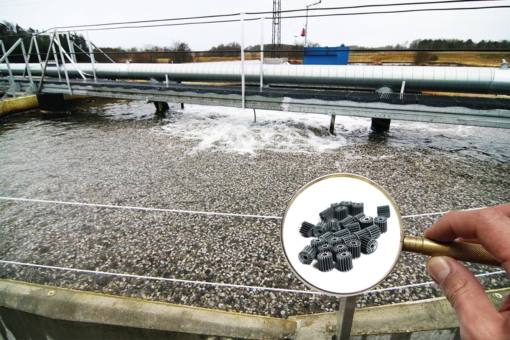
A clean and pure water source, without contaminants or pathogens, is a necessity in a RAS.
The moving bed filter is one of the biofilters in which the primary objective is to control the un-ionised ammonia (NH3) concentration of the water, as this is very toxic to fish.
Bio-media
 A moving bed filter contains bio-elements like beads, chips or porous foam with a high specific surface area on which the nitrifying bacteria can live. Usually, the filter contains around 50% water and 50% bio-elements, which are moved around by blowers at the bottom of the filter. In this way, the bacteria living on the bio-elements have constant access to oxygen and ammonia. The efficiency of the biofilter is directly linked to the total amount of bacteria in the filter. In order to have a compact moving bed filter, it is desirable to have a high specific, protected, surface filter medium on which the nitrifying bacteria can attach and grow. There are different types of bio-media, each with their own specifications, on the market.
A moving bed filter contains bio-elements like beads, chips or porous foam with a high specific surface area on which the nitrifying bacteria can live. Usually, the filter contains around 50% water and 50% bio-elements, which are moved around by blowers at the bottom of the filter. In this way, the bacteria living on the bio-elements have constant access to oxygen and ammonia. The efficiency of the biofilter is directly linked to the total amount of bacteria in the filter. In order to have a compact moving bed filter, it is desirable to have a high specific, protected, surface filter medium on which the nitrifying bacteria can attach and grow. There are different types of bio-media, each with their own specifications, on the market.
Besides the surface area of the filter medium, other important factors determining the rate at which the conversion of ammonia to nitrate takes place are ammonia concentration, O2 level, water temperature, pH, and organic matter in the system water. It is important to realise that prior to nitrification, as much organic matter as possible must be removed, as it will otherwise negatively interfere with nitrification. Organic matter in the moving bed filter can smother the nitrifying bacteria, and it may even lead to the development of heterotrophic bacteria that grow much faster than nitrifying bacteria. Again, this filter needs to be monitored daily, and care must be taken that the bacteria have the right conditions to break down ammonia. A RAS farmer not only has to look after the fish but also after the bacteria.
 Constant Movement
Constant Movement
The moving bed biofilter predominantly performs nitrification, but also some aeration and degassing. The beads or other bio-elements need to be in motion at all times, in every part of the filter! No dead areas are allowed to develop, as unwanted accumulation of organic matter could take place, and anaerobic conditions could arise. Strong aeration is, therefore, required. The aeration also maintains the optimal oxygen level for the bacteria.
Figure. Example of a moving bed biofilter. Constant movement of all the biofilter media is essential for optimal nitrification, aeration and degassing. The moving bed filter is generally located after the fixed bed filter and before the degasser and oxygen enrichment, ahead of the water returning to the culture tank.
Some of the CO2 in the water will be stripped, as well as any N2 gas produced due to denitrification in the fixed bed filter. Because of the turbulence, the elements bump against each other, which leads to self-cleaning (no backwash needed). It also means that the nitrifying bacteria can only attach at the protected surface of the bio-elements. When moving bed filters are used, it is important to check that no air bubbles are taken with the water flow into the pumps, as this could lead to nitrogen supersaturation. From 102%, nitrogen supersaturation gas bubble disease can occur, and this, of course, must be prevented. In principle, the degasser will remove the excess nitrogen, but it is better to be safe than sorry.
 Nitrification (aerobic process)
Nitrification (aerobic process)
Ammonia is converted into nitrate (NO3-) in two steps by two groups of nitrifying bacteria. Firstly, ammonia is oxidised to nitrite (NO2-) by several bacterial species, of which the most common genus is Nitrosomonas. Secondly, nitrite — which is also toxic to fish but not as much as ammonia (NH3) — is then further oxidised by several groups of bacteria, of which the most well-known is Nitrobacter. This final oxidation produces nitrate. Nitrate will accumulate but is not highly toxic to fish, although it can reduce feed intake at high levels. That is why nitrate must be controlled by daily or continuous replacement of old water or by denitrification in another biofilter. Bacteria require sufficient oxygen for nitrification.
 Denitrification (anoxic process)
Denitrification (anoxic process)
Denitrification is the breakdown of nitrate into molecular nitrogen (N2) gas. Many bacterial species can perform the denitrification process. Most denitrifiers are heterotrophic bacteria living under anoxic or oxygen-poor conditions. During this process, nitrate provides the oxygen molecule and the organic matter is used as a carbon source, thereby also producing CO. A third process in biofilters is organic breakdown by heterotrophic bacteria. This is an aerobic process. In trout farming, a combination of two biofilters is often used: the fixed bed filter and the moving bed filter.
Designed to meet specific
performance criteria
For biological filter design, it is essential to calculate the expected daily total ammonia load and the bio-media surface area required to handle that load at the water temperature of the farm. For proper dimensioning, information regarding the ammonia production per kg of feed is vital and can vary based on the type of feed used. Factors influencing the way trout use feed include water temperature, feed composition, feeding level, feed digestibility and feed utilisation.
